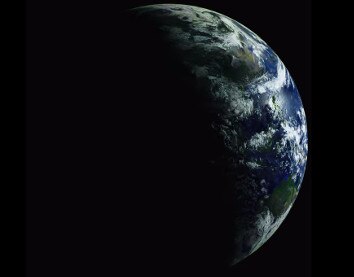Create a free profile to get unlimited access to exclusive videos, sweepstakes, and more!
As the Earth Turns

Last week, I highlighted an amazing video of the Sun taken from space in super-hi-def resolution, put together from NASA imagery by James Tyrwhitt-Drake.
Today, how about we turn that around, look down, and do the same thing for our fair planet?
Here’s the Earth, as seen by the Russian Roscosmos’s Elektro-L satellite from May 15–19, 2011, and put together into a video again by Tyrwhitt-Drake. Set it to maximum resolution and make it full screen, and soak up the incredible beauty of home.
Fantastic, isn’t it? But it also takes some explaining.
First, Elektro-L is an Earth-observing weather satellite. It’s in a geosynchronous orbit, meaning it goes around the Earth once every 24 hours, the time it takes the Earth to spin once. From our point of view that means the satellite is fixed in the sky, neither rising nor setting. From the satellite’s point of view the Earth always shows the same face; looking down it always sees the same part of Earth. That’s why a geosynch orbit is so useful for weather. The video makes that obvious, too.
The satellite has cameras sensitive to visible light—the kind we see—and near-infrared. Plants reflect that kind of light very strongly, so places where there’s vegetation show up strongly in the satellite images. Normally those are colored red in pictures, but for this video Tyrwhitt-Drake colored that channel a more natural-looking green. Plants aren't the only thing that reflect IR light, so some places look green that aren't; note Saudi Arabia, for example, and the Sahara, which have a yellow-green tint from sand.
If the motion looks odd to you, that’s because Tyrwhitt-Drake had to interpolate between frames taken every 30 minutes by Elektro-L. (I explain how this is done in a post about a video of the Curiosity Mars rover landing.) It creates an odd flowing effect but is far better than the jerky snap between images taken so long apart.
Also, the video only shows the Northern Hemisphere first, then the southern flipped over (note the shadow line between night and day, called the terminator, moves the other way), and then finally the whole Earth at lower but still spectacular resolution.
Incredibly, the images off the satellite are originally 11K x 11K (each 120 megapixels!), which Tyrwhitt-Drake resized down to 50 percent, presumably so it would take less than a century to render the video. He says his 5,568 x 5,568 pixel video is available upon request. That would be amazing … if I had a monitor with enough resolution to see it! Maybe I could stitch 25 TVs together …
Tip o' the chlorophyll to Fraser Cain.


























